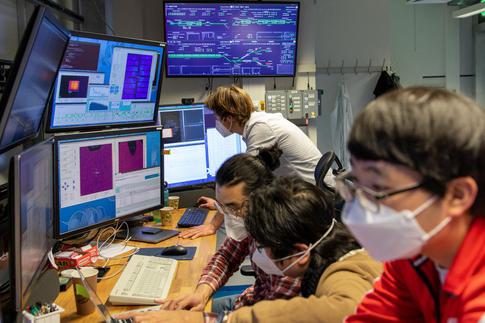XFEL: Beaming in on Coronavirus details
Beaming in on Coronavirus details

A shot from the control hutch showing one of the first COVID-related beamtimes at SPB/SFX. Copyright: European XFEL.
“Three user collaborations have proposed experiments that will use two distinct approaches to study the Coronavirus. Two collaborations lead by scientists from DESY and Diamond Light Source will look at the structure and binding of ligands to the proteases of the Coronavirus,” says Adrian Mancuso, leading scientist at the SPB/SFX instrument. A ligand is a molecule that binds another specific molecule or atom. Some ligands deliver a signal during the binding process and can be thought of as signaling molecules, which interact with proteins in target cells called receptors. At the European XFEL, scientists can potentially observe the process of these ligands attaching to proteins at atomic resolution, however, first an ordered crystal of the relevant protein is required. “XFELs are uniquely positioned to watch how irreversible processes in proteins—such as binding of potential drug candidates—happen,” explains Mancuso.
The EMBL-led collaboration will study the viability of small angle scattering at the SPB/SFX instrument. Small angle scattering is a powerful method for the structural characterization of both ordered and disordered proteins in solution, which means that the proteins can be studied without the need for crystallization. “While the main goal of the user collaboration is to test the viability of small angle scattering at European XFEL to study proteins in general, they also hope to see new data from Coronavirus proteins,” says Mancuso.
“These experiments are very challenging because of the combination of getting the right kind of sample from the Coronavirus and the novel approaches being used to study these samples,” explains Mancuso. Due to the pandemic, very few users can be on-site. Staff scientists, engineers and technicians at European XFEL therefore have been involved at every step of the experimental set up and runtime, and most users will follow the experiments remotely. “We hope that all the user tools work well in our environment. And if the experiments are successful, they can contribute to the fight against the Coronavirus,” says Mancuso.
